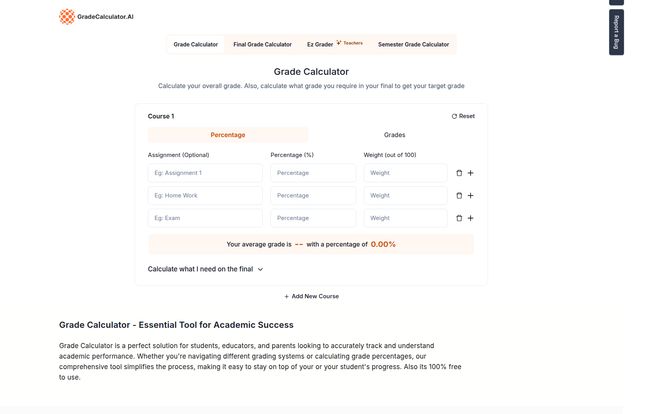You know the feeling. It’s two weeks before the end of the semester. You’re staring at your course syllabus, which now looks less like a helpful guide and more like a cryptic treasure map where ‘X’ marks the spot of your potential failure. You’ve got a 78 on the midterm, a 92 and a 65 on two major papers, and a smattering of homework grades. The final exam is worth 40% of your total grade. What do you need to score to pass? To get a B? To salvage your GPA?
I’ve been there. My own college days were filled with frantic, back-of-the-napkin calculations, usually fueled by cheap coffee and sheer desperation. I’d build these monstrous spreadsheets that would inevitably break because I’d missed a parenthesis somewhere. It was a whole ordeal. So when I stumbled upon a tool called GradeCalculator.AI, my inner, perpetually stressed-out student perked up. A simple, free online grade calculator? Skeptical, but intrigued.
Let’s be honest, the internet is littered with “free” tools that are anything but. They’re usually clunky, plastered with a million blinking ads, or they hit you with a paywall right at the moment of truth. So, I decided to put this one through its paces. For science. And for all of you who are tired of doing grade math by hand.
First Impressions of GradeCalculator.AI
Pulling up the website, the first thing I noticed was… nothing. And I mean that in the best way possible. There were no pop-ups demanding my email. No distracting video ads. No confusing navigation. It’s clean. Simple. No fluff.
The interface is incredibly straightforward. You see fields for your assignments, your scores, and the weight of each assignment. That’s it. It’s designed to do one job—calculate your grade—and it doesn’t waste your time with anything else. This minimalist approach is so refreshing. It’s less of a bloated Swiss Army knife and more of a perfectly sharpened chef’s knife. It does one thing, and it does it brilliantly.

Visit GradeCalculator.AI
It’s clear this tool was built with a user-first mindset, which is a rarity these days. They know you’re probably stressed when you land on their page, and the last thing you need is more confusion.
Putting the Calculator to the Test
Alright, let’s take it for a spin with a real-world scenario. Imagine we're in a classic 'Biology 101' course. The grading is broken down like this:
- Lab Reports: 25%
- Midterm Exam: 30%
- Quizzes: 10%
- Final Exam: 35%
Calculating Your Current Grade
First, I want to figure out where I stand before the final. I start plugging in my scores. The tool lets you add new assignments with a click. So, I enter my lab report average (say, 88%), my midterm score (a slightly disappointing 75%), and my quiz average (a solid 95%).
As I input each value and its weight, the tool crunches the numbers in real time. There’s no big, scary “CALCULATE” button you have to press with your eyes closed. The feedback is instant. This immediate result is a small detail, but it does wonders for reducing anxiety. You’re in control, seeing how each component affects the whole.
The Magic 'What Do I Need on the Final?' Feature
This is the main event, isn't it? This is the question that keeps students up at night. GradeCalculator.AI has a dedicated function for this. Once you've entered all your existing grades, you can use the "Final Grade Calculator" feature. You tell it the weight of your final exam (in our case, 35%) and the overall grade you’re hoping to achieve in the class (let's aim for a B, so an 80%).
With one click, it tells you the exact score you need on that final to hit your target. No more guesswork. No more bargaining with the universe. It lays out the facts: to get a B, you need an 82.5% on the final. Suddenly, the path forward is clear. The goal is defined. You know what you need to do. For a student, that clarity is priceless.
More Than Just a Simple Number Cruncher
While its primary function is simple, the tool has some nice depth to it that makes it more broadly useful. It’s not just for US-based university students with a standard weighted system.
Understanding Different Grading Systems
The site acknowledges that grading isn’t a one-size-fits-all deal. It explicitly mentions its compatibility with percentage-based systems (the most common), letter grades, and GPA systems. This versatility is a big plus. It means a high school parent, a college student, or even an international student could find it useful. It also provides a basic rundown of these systems, which is a nice touch for those who might be unfamiliar with, say, how a 4.0 GPA scale works. For a more detailed breakdown of GPA, the College Board has a pretty good explanation.
The Handy Grade Conversion Table
One of my favorite little extras on the site is the Grade Conversion Table. It’s a simple chart that shows the typical relationship between GPA, letter grades, and percentages. It's incredibly useful for a quick gut check. "Wait, is an 88% a B+ or an A- at this school?" Just a quick glance at the table gives you a general idea.
| GPA | Letter Grade | Percentage |
|---|---|---|
| 4.0 | A | 93% - 100% |
| 3.7 | A- | 90% - 92% |
| 3.3 | B+ | 87% - 89% |
| 3.0 | B | 83% - 86% |
Note: This is a general guide; your specific institution's scale may vary!
So, What's the Catch? A Reality Check
Okay, it can’t all be sunshine and easy As, right? The tool is fantastic, but it's not a magic wand. There are a couple of things to keep in mind.
The most obvious one is that it requires manual input. This isn’t a flaw in the tool itself, just a reality of how it works. Its accuracy is 100% dependent on the accuracy of the numbers you feed it. Garbage in, garbage out, as the old saying goes. If you forget to add a quiz score or mistype the weight of your midterm, your result will be wrong. So, double-check your syllabus and your numbers!
Secondly, while it’s versatile, it might not accommodate every single bizarre grading scheme out there. Some professors, bless their hearts, come up with some truly creative weighting systems. "The top 8 of your 10 homework assignments count," or "Class participation is 15%, judged by vibes." If your course has rules like that, a simple weighted grade calculator might not capture teh full picture. For the vast majority of standard courses, though, it’s perfect.
Who is GradeCalculator.AI Really For?
This is one of those rare tools that has a genuinely broad audience.
For students, it's a no-brainer. It demystifies the grading process and turns anxiety into an actionable plan. I wish I'd had this in school.
For parents, it’s a fantastic way to stay in the loop without having to become a master of the school’s online portal. If you're trying to help your kid figure out their academic standing, you can sit down together, plug in the numbers, and see a clear result in seconds. It can be a great starting point for a conversation about study habits.
For teachers and educators, while you have your own sophisticated gradebooks, this could be a handy tool to recommend to students. It empowers them to take ownership of their grades and understand exactly how your grading system works. You could even use it in class to demonstrate the power of weighting.
The Final Verdict: Is It Worth Your Clicks?
Absolutely. Yes. 100%.
In an internet saturated with tools that want your data, your money, or your attention, GradeCalculator.AI wants nothing but to help you solve a problem. It’s fast, accurate, user-friendly, and most importantly, truly free. There are no hidden costs, no premium versions, no sign-ups. It’s just a well-made tool offered up for anyone to use.
It won't write your papers for you or take your exams, but it will give you something almost as valuable: clarity and peace of mind. And in the chaotic world of academia, that's worth its weight in gold.
Frequently Asked Questions (FAQ)
- Is GradeCalculator.AI really free to use?
- Yep. I looked for the catch, and there isn't one. The site states it's 100% free to use for students, educators, and parents. No fees, no subscriptions.
- How accurate is this online grade calculator?
- The math is solid. The calculator's accuracy is entirely dependent on you entering the correct scores and weights from your course syllabus. Always double-check your inputs!
- Can I use it to calculate my overall GPA?
- While it has a GPA conversion table and supports GPA systems for individual course calculations, it's primarily designed as a course grade calculator, not a cumulative GPA calculator for all your courses over multiple semesters. You'd calculate each course grade here, then use those final grades to calculate your semester GPA.
- Do I need to create an account or sign up?
- Nope! This is a huge plus in my book. You can just go to the site and start calculating immediately. No personal data required.
- What if my teacher drops the lowest grade?
- This is a great question. For a scenario like that, you would manually exclude your lowest grade from the numbers you enter into the calculator. The tool doesn't automate 'drop the lowest' rules, so you have to do that part yourself before you input the data.
Conclusion
Look, managing your academic life is stressful enough. Anything that can reduce that stress and replace confusion with clarity is a win. GradeCalculator.AI is a simple, elegant solution to a problem every single student faces. It empowers you with information, helping you strategize for finals and finish the semester strong. So next time you feel that familiar wave of panic, take a deep breath, pull up the site, and turn that anxiety into a concrete number you can work with.
Reference and Sources
- GradeCalculator.AI: https://gradecalculator.ai
- College Board - How to Calculate GPA: https://bigfuture.collegeboard.org/gpa-calculator-and-gpa-scale/how-to-calculate-gpa-and-understand-gpa-scales



